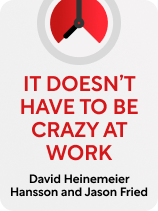

This article is an excerpt from the Shortform book guide to "It Doesn't Have to Be Crazy at Work" by David Heinemeier Hansson and Jason Fried. Shortform has the world's best summaries and analyses of books you should be reading.
Like this article? Sign up for a free trial here.
Does your workplace support a “hustle culture?” Do you know how to create a healthy work environment?
In unhealthy work environments, employees and managers work nights and weekends, practically live at the office, and attack their jobs with a frantic intensity. Jason Fried and David Heinemeier Hansson argue that this mindset isn’t necessary for an efficient business.
Let’s look at how managers can encourage a work environment that isn’t built on unhealthy practices.
Stable Success at Work
Instead of constantly setting bigger and more ambitious goals for your company, Fried and Hansson recommend defining success for your organization as the ongoing completion of the same stable goals. For instance, when learning how to create a healthy work environment, you may aim to deliver a product you’re proud of and provide great customer service. Settle into a work routine that makes your team happy and be satisfied with that—as long as the business is profitable, there’s no need to expand it to a scale that’s more stressful to manage. For example, if you run a landscaping business, make it your goal to serve a single city well season after season instead of expanding to manage teams across the country.
This doesn’t mean your organization can’t grow and progress—Fried and Hansson advocate refining and improving your workplace over time. Constantly stay on the lookout for ways to better accomplish your stable goals, as well as ways to make life for you and your employees as enjoyable as possible.
| A Middle Ground: Profit First If you’d like to strike a middle ground between traditional growth-centered business strategy and Fried and Hansson’s radical perspective of sticking to the same stable goals, consider using the “Profit First” method, as described by Mike Michalowicz in Profit First. Determine what percentage of revenue you want to save as profit before deciding how much revenue you want to reinvest in growth. Then, allow your company to grow as fast as it can without reinvesting more than you’ve allocated. This strategy allows you to tackle ambitious goals while maintaining a cushion of profit to support the company and avoid painful cutbacks if business slows down. The more revenue you earn, the faster your company will grow—but the profits you set aside ensure you’re not spending more than you can afford. You can also use these savings to support your company’s comfortable work routine, even as you grow—as Fried and Hansson would recommend. For example, if you want to offer your employees a four-day workweek, you can factor this into your expenses and only expand as you earn more than enough to support this perk. Once you’ve set this system up, Michalowicz also recommends refining your workplace procedures over time. He expands on Fried and Hansson’s advice, suggesting that managers focus particularly on major sweeping changes rather than marginal refinements. For example, consider Netflix in 2007: Instead of looking for ways to make their DVD-by-mail service slightly more cost-effective (like developing more lightweight packaging), they developed an on-demand streaming platform that would make their company more valuable to consumers for years to come. |

———End of Preview———
Like what you just read? Read the rest of the world's best book summary and analysis of David Heinemeier Hansson and Jason Fried's "It Doesn't Have to Be Crazy at Work" at Shortform.
Here's what you'll find in our full It Doesn't Have to Be Crazy at Work summary:
- How today's "hustle culture" ruins the lives of many
- How you can establish more reasonable and sustainable goals
- The three qualifications to look for when scouting for any potential hire





